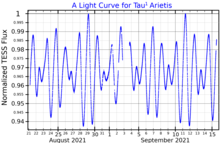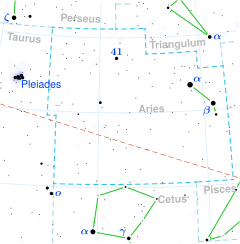| Observation data Epoch J2000 Equinox J2000 | |
|---|---|
| Constellation | Aries |
| Right ascension | 03h 21m 13.62462s [1] |
| Declination | +21° 08′ 49.4390″ [1] |
| Apparent magnitude (V) | 5.27 [2] |
| Characteristics | |
| Spectral type | B5 IV [3] |
| U−B color index | −0.53 [2] |
| B−V color index | −0.06 [2] |
| Astrometry | |
| Radial velocity (Rv) | +14 [4] km/s |
| Proper motion (μ) |
RA: +25.651
[1]
mas/
yr Dec.: −19.850 [1] mas/ yr |
| Parallax (π) | 6.1786 ± 0.2066 mas [1] |
| Distance | 530 ± 20
ly (162 ± 5 pc) |
| Absolute magnitude (MV) | −0.66 [5] |
| Details | |
| Mass | 5.0±0.1 [6] M☉ |
| Radius | 4.45 [1] R☉ |
| Luminosity | 234 [5] L☉ |
| Surface gravity (log g) | 3.68 [1] cgs |
| Temperature | 12,606 [1] K |
| Metallicity [Fe/H] | −0.63 [1] dex |
| Rotational velocity (v sin i) | 30 [7] km/s |
| Age | 54.8±5.4 [6] Myr |
| Other designations | |
| Database references | |
| SIMBAD | data |
Tau1 Arietis, Latinized from τ1 Arietis, is the Bayer designation for a triple star system [9] in the northern constellation of Aries. Based upon an annual parallax shift of 6.1786 mas, it is approximately 530 light-years (162 parsecs) distant from Earth. The combined apparent visual magnitude is 5.27, [2] making it faintly visible to the naked eye.

The Tau1 Arietis system contains three stars. The inner pair form an eclipsing binary system, with the brightness of the pair decreasing by 0.06 in magnitude during an eclipse of the primary. [11] Its period is 2.20356 days. [12] The third component is located at an angular separation of 0.810 arcseconds and has a magnitude of 8.17. [9] The primary component is a subgiant star with a stellar classification of B5 IV. [3] It has five times the mass of the Sun [6] with about four times the Sun's radius. [1]
This system is a member of the Cas-Tau OB association of stars that share a common motion through space. [13]
- ^ a b c d e f g h i j Vallenari, A.; et al. (Gaia collaboration) (2023). "Gaia Data Release 3. Summary of the content and survey properties". Astronomy and Astrophysics. 674: A1. arXiv: 2208.00211. Bibcode: 2023A&A...674A...1G. doi: 10.1051/0004-6361/202243940. S2CID 244398875. Gaia DR3 record for this source at VizieR.
- ^ a b c d Crawford, D. L.; Barnes, J. V.; Golson, J. C. (1971), "Four-color, H-beta, and UBV photometry for bright B-type stars in the northern hemisphere", The Astronomical Journal, 76: 1058, Bibcode: 1971AJ.....76.1058C, doi: 10.1086/111220.
- ^ a b Lesh, Janet Rountree (December 1968), "The Kinematics of the Gould Belt: an Expanding Group?", Astrophysical Journal Supplement, 17: 371, Bibcode: 1968ApJS...17..371L, doi: 10.1086/190179.
- ^ Evans, D. S. (June 20–24, 1966), "The Revision of the General Catalogue of Radial Velocities", in Batten, Alan Henry; Heard, John Frederick (eds.), Determination of Radial Velocities and their Applications, Proceedings from IAU Symposium no. 30, vol. 30, University of Toronto: International Astronomical Union, p. 57, Bibcode: 1967IAUS...30...57E.
- ^ a b Anderson, E.; Francis, Ch. (2012), "XHIP: An extended hipparcos compilation", Astronomy Letters, 38 (5): 331, arXiv: 1108.4971, Bibcode: 2012AstL...38..331A, doi: 10.1134/S1063773712050015, S2CID 119257644.
- ^ a b c Tetzlaff, N.; Neuhäuser, R.; Hohle, M. M. (January 2011), "A catalogue of young runaway Hipparcos stars within 3 kpc from the Sun", Monthly Notices of the Royal Astronomical Society, 410 (1): 190–200, arXiv: 1007.4883, Bibcode: 2011MNRAS.410..190T, doi: 10.1111/j.1365-2966.2010.17434.x, S2CID 118629873.
- ^ Abt, Helmut A.; Levato, Hugo; Grosso, Monica (July 2002), "Rotational Velocities of B Stars", The Astrophysical Journal, 573 (1): 359–365, Bibcode: 2002ApJ...573..359A, doi: 10.1086/340590.
- ^ "tau01 Ari", SIMBAD, Centre de données astronomiques de Strasbourg, retrieved 2012-08-11.
- ^ a b Eggleton, P. P.; Tokovinin, A. A. (September 2008), "A catalogue of multiplicity among bright stellar systems", Monthly Notices of the Royal Astronomical Society, 389 (2): 869–879, arXiv: 0806.2878, Bibcode: 2008MNRAS.389..869E, doi: 10.1111/j.1365-2966.2008.13596.x, S2CID 14878976.
- ^ MAST: Barbara A. Mikulski Archive for Space Telescopes, Space Telescope Science Institute, retrieved 8 December 2021.
- ^ Malkov, O. Yu.; et al. (February 2006), "A catalogue of eclipsing variables", Astronomy and Astrophysics, 446 (2): 785–789, Bibcode: 2006A&A...446..785M, doi: 10.1051/0004-6361:20053137, hdl: 10995/73280.
- ^ "tau 1 Ari", The International Variable Star Index, AAVSO, retrieved 17 July 2022.
- ^ de Zeeuw, P. T.; et al. (January 1999), "A HIPPARCOS Census of the Nearby OB Associations", The Astronomical Journal, 117 (1): 354–399, arXiv: astro-ph/9809227, Bibcode: 1999AJ....117..354D, doi: 10.1086/300682, S2CID 16098861.
| Observation data Epoch J2000 Equinox J2000 | |
|---|---|
| Constellation | Aries |
| Right ascension | 03h 21m 13.62462s [1] |
| Declination | +21° 08′ 49.4390″ [1] |
| Apparent magnitude (V) | 5.27 [2] |
| Characteristics | |
| Spectral type | B5 IV [3] |
| U−B color index | −0.53 [2] |
| B−V color index | −0.06 [2] |
| Astrometry | |
| Radial velocity (Rv) | +14 [4] km/s |
| Proper motion (μ) |
RA: +25.651
[1]
mas/
yr Dec.: −19.850 [1] mas/ yr |
| Parallax (π) | 6.1786 ± 0.2066 mas [1] |
| Distance | 530 ± 20
ly (162 ± 5 pc) |
| Absolute magnitude (MV) | −0.66 [5] |
| Details | |
| Mass | 5.0±0.1 [6] M☉ |
| Radius | 4.45 [1] R☉ |
| Luminosity | 234 [5] L☉ |
| Surface gravity (log g) | 3.68 [1] cgs |
| Temperature | 12,606 [1] K |
| Metallicity [Fe/H] | −0.63 [1] dex |
| Rotational velocity (v sin i) | 30 [7] km/s |
| Age | 54.8±5.4 [6] Myr |
| Other designations | |
| Database references | |
| SIMBAD | data |
Tau1 Arietis, Latinized from τ1 Arietis, is the Bayer designation for a triple star system [9] in the northern constellation of Aries. Based upon an annual parallax shift of 6.1786 mas, it is approximately 530 light-years (162 parsecs) distant from Earth. The combined apparent visual magnitude is 5.27, [2] making it faintly visible to the naked eye.

The Tau1 Arietis system contains three stars. The inner pair form an eclipsing binary system, with the brightness of the pair decreasing by 0.06 in magnitude during an eclipse of the primary. [11] Its period is 2.20356 days. [12] The third component is located at an angular separation of 0.810 arcseconds and has a magnitude of 8.17. [9] The primary component is a subgiant star with a stellar classification of B5 IV. [3] It has five times the mass of the Sun [6] with about four times the Sun's radius. [1]
This system is a member of the Cas-Tau OB association of stars that share a common motion through space. [13]
- ^ a b c d e f g h i j Vallenari, A.; et al. (Gaia collaboration) (2023). "Gaia Data Release 3. Summary of the content and survey properties". Astronomy and Astrophysics. 674: A1. arXiv: 2208.00211. Bibcode: 2023A&A...674A...1G. doi: 10.1051/0004-6361/202243940. S2CID 244398875. Gaia DR3 record for this source at VizieR.
- ^ a b c d Crawford, D. L.; Barnes, J. V.; Golson, J. C. (1971), "Four-color, H-beta, and UBV photometry for bright B-type stars in the northern hemisphere", The Astronomical Journal, 76: 1058, Bibcode: 1971AJ.....76.1058C, doi: 10.1086/111220.
- ^ a b Lesh, Janet Rountree (December 1968), "The Kinematics of the Gould Belt: an Expanding Group?", Astrophysical Journal Supplement, 17: 371, Bibcode: 1968ApJS...17..371L, doi: 10.1086/190179.
- ^ Evans, D. S. (June 20–24, 1966), "The Revision of the General Catalogue of Radial Velocities", in Batten, Alan Henry; Heard, John Frederick (eds.), Determination of Radial Velocities and their Applications, Proceedings from IAU Symposium no. 30, vol. 30, University of Toronto: International Astronomical Union, p. 57, Bibcode: 1967IAUS...30...57E.
- ^ a b Anderson, E.; Francis, Ch. (2012), "XHIP: An extended hipparcos compilation", Astronomy Letters, 38 (5): 331, arXiv: 1108.4971, Bibcode: 2012AstL...38..331A, doi: 10.1134/S1063773712050015, S2CID 119257644.
- ^ a b c Tetzlaff, N.; Neuhäuser, R.; Hohle, M. M. (January 2011), "A catalogue of young runaway Hipparcos stars within 3 kpc from the Sun", Monthly Notices of the Royal Astronomical Society, 410 (1): 190–200, arXiv: 1007.4883, Bibcode: 2011MNRAS.410..190T, doi: 10.1111/j.1365-2966.2010.17434.x, S2CID 118629873.
- ^ Abt, Helmut A.; Levato, Hugo; Grosso, Monica (July 2002), "Rotational Velocities of B Stars", The Astrophysical Journal, 573 (1): 359–365, Bibcode: 2002ApJ...573..359A, doi: 10.1086/340590.
- ^ "tau01 Ari", SIMBAD, Centre de données astronomiques de Strasbourg, retrieved 2012-08-11.
- ^ a b Eggleton, P. P.; Tokovinin, A. A. (September 2008), "A catalogue of multiplicity among bright stellar systems", Monthly Notices of the Royal Astronomical Society, 389 (2): 869–879, arXiv: 0806.2878, Bibcode: 2008MNRAS.389..869E, doi: 10.1111/j.1365-2966.2008.13596.x, S2CID 14878976.
- ^ MAST: Barbara A. Mikulski Archive for Space Telescopes, Space Telescope Science Institute, retrieved 8 December 2021.
- ^ Malkov, O. Yu.; et al. (February 2006), "A catalogue of eclipsing variables", Astronomy and Astrophysics, 446 (2): 785–789, Bibcode: 2006A&A...446..785M, doi: 10.1051/0004-6361:20053137, hdl: 10995/73280.
- ^ "tau 1 Ari", The International Variable Star Index, AAVSO, retrieved 17 July 2022.
- ^ de Zeeuw, P. T.; et al. (January 1999), "A HIPPARCOS Census of the Nearby OB Associations", The Astronomical Journal, 117 (1): 354–399, arXiv: astro-ph/9809227, Bibcode: 1999AJ....117..354D, doi: 10.1086/300682, S2CID 16098861.
